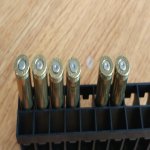Hi Folks,
Had some reloaded ammo trouble today at the range.
In the 1500 rounds of reloaded 223, I have had one ftf (forgot the powder) until today.
Since my go to H335 is scarce at the moment, I was running a ladder test with Nosler 55 grain balistic tips and some BL-C(2) that I got for cheap at Canadian Tire. I had 3 of each charge times 8 different charges. 25.8 to 27.6 grains.
Right away there was problems. Heard that click and removed the round to see a light primer strike. Some would fire on the second try, some on the third. After this went on for awhile, I was starting to suspect my Tikka TX3 bolt. So I popped some different ammo in and it all shot as usual.
Back to the Nosler loaded rounds and nothing but trouble. Out of the 24 rounds, about 18 failed to fire on the first try. The primers were (at least I thought) CCI #400 Small Rifle Primers. Back to trying some ammo loaded at a way different date. Again no problem.
What would happen if one day I was head-in-the-clouds and picked up the package of small pistol primers? The CCI trays are identical in colour.
Here is a picture of some of the rounds:
1. Unfired
2. Struck once, ftf
3. Struck twice to fire (lifting)
4. Struck multiple times to fire, flattened
5. Empty slot
6 & 7. Different ammo loaded at a different time

Had some reloaded ammo trouble today at the range.
In the 1500 rounds of reloaded 223, I have had one ftf (forgot the powder) until today.
Since my go to H335 is scarce at the moment, I was running a ladder test with Nosler 55 grain balistic tips and some BL-C(2) that I got for cheap at Canadian Tire. I had 3 of each charge times 8 different charges. 25.8 to 27.6 grains.
Right away there was problems. Heard that click and removed the round to see a light primer strike. Some would fire on the second try, some on the third. After this went on for awhile, I was starting to suspect my Tikka TX3 bolt. So I popped some different ammo in and it all shot as usual.
Back to the Nosler loaded rounds and nothing but trouble. Out of the 24 rounds, about 18 failed to fire on the first try. The primers were (at least I thought) CCI #400 Small Rifle Primers. Back to trying some ammo loaded at a way different date. Again no problem.
What would happen if one day I was head-in-the-clouds and picked up the package of small pistol primers? The CCI trays are identical in colour.
Here is a picture of some of the rounds:
1. Unfired
2. Struck once, ftf
3. Struck twice to fire (lifting)
4. Struck multiple times to fire, flattened
5. Empty slot
6 & 7. Different ammo loaded at a different time










































































